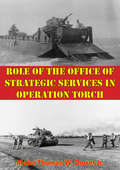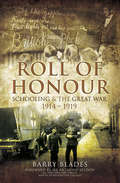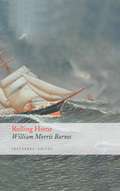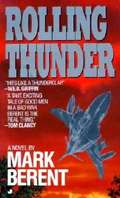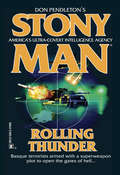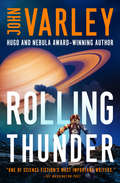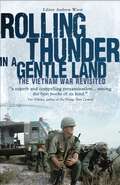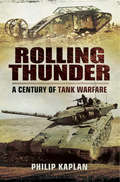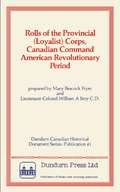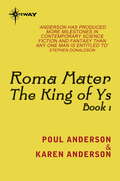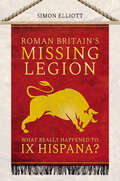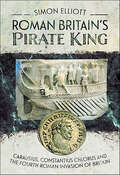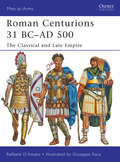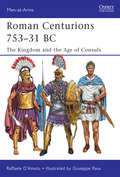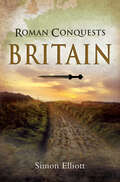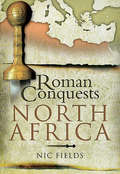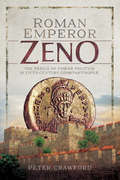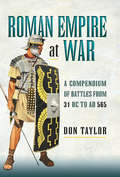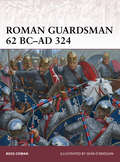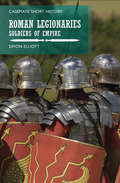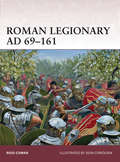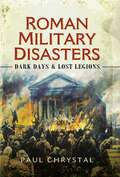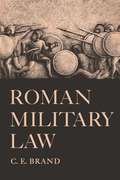- Table View
- List View
Role Of The Office Of Strategic Services In Operation Torch
by Major Thomas W. Dorrel Jr.This thesis evaluates the role of Allied strategic and operational intelligence in conjunction with Department of State actions in French North Africa from 1940 through the invasion, Operation TORCH, November 8, 1942. The primary focus is to evaluate whether or not the OSS collected the required intelligence information as their accounts have stated. This paper also looks at the operational requirements of advance force operations to determine if the OSS was successful in accomplishing the required tasks for the operational planning and execution of Operation TORCH. The final analysis reveals that the OSS was successful in answering most of the information requirements, but only with the help of other Allied intelligence collection agencies.
Roll of Honour: Schooling & The Great War, 1914–1919
by Barry BladesThe Great War was the first 'Total War'; a war in which human and material resources were pitched into a life-and-death struggle on a colossal scale. British citizens fought on both the Battle Fronts and on the Home Front, on the killing fields of France and Flanders as well as in the industrial workshops of 'Blighty'. Men, women and children all played their part in an unprecedented mobilisation of a nation at war. Unlike much of the traditional literature on the Great War, with its understandable fascination with the terrible experiences of 'Tommy in the Trenches', Roll of Honour shifts our gaze. It focuses on how the Great War was experienced by other key participants, namely those communities involved in 'schooling' the nation's children. It emphasises the need to examine the 'myriad faces of war', rather than traditional stereotypes, if we are to gain a deeper understanding of personal agency and decision making in times of conflict and upheaval. The dramatis personae in Roll of Honour include Head Teachers and Governors charged by the Government with mobilising their 'troops'; school masters, whose enlistment, conscription or conscientious objection to military service changed lives and career paths; the 'temporary' school mistresses who sought to demonstrate their 'interchangeability' in male dominated institutions; the school alumni who thought of school whilst knee-deep in mud; and finally, of course, the school children themselves, whose 'campaigns' added vital resources to the war economy. These 'myriad faces' existed in all types of British school, from the elite Public Schools to the elementary schools designed for the country's poorest waifs and strays. This powerful account of the Great War will be of interest to general readers as well as historians of military campaigns, education and British society.
Rolling Back the Islamic State
by James Dobbins Seth G. Jones Christopher S. Chivvis Jeffrey Martini Daniel Byman Ben Connable Eric Robinson Nathan ChandlerThe Islamic State has lost substantial amounts of territory but continues to conduct and inspire attacks around the world. This report assesses the threat the Islamic State poses to the United States and examines strategies to counter the group and prevent a resurgence of the Islamic State or other Salafi-jihadist groups.
Rolling Home (Seafarers' Voices)
by William Morris BarnesBarnes was born in 1850 into a shipowning family in St Johns, Newfoundland, and first went to sea while still a schoolboy. His career seemed predestined, and by the age of 14 he was apprenticed to a Liverpool company, serving in their sailing ships working a triangular passage to St Johns, the Brazils and back to Liverpool. He tried to swallow the anchor when he married but running a grocery store was too mundane, and he soon went back to sea, transferring his skills to the now dominant steamships.Even though he was 64, on the outbreak of the First World War he promptly volunteered for service. He does not seem to have regretted it, even after being mined or torpedoed three times; the last time he was badly injured and spent three days adrift in an open boat. Despite these disasters, like many a sailor, he was probably safer at sea while in one port he fell for a rather exotic woman, only to discover she was a German spy. When he eventually retired, to New York, he got to know a couple called Hilda and Denys Wortman. Denys was a newspaper cartoonist, who was rather taken with the gruff old sea-dog and based a character he dubbed Mopy Dick on him for a series of popular cartoons. Meanwhile, Hilda encouraged Barnes to record his adventures and she eventually became the editor of the first edition of this book, imbuing the story with far more narrative flair than usually found in unliterary memoirs.
Rolling Thunder
by Mark BerentThey were America's bravest men - seasoned veterans and young daredevil pilots with dreams of glory in the air.... Court Bannister, an Air Force Captain overshadowed by his famous father, driven to prove his worth to his comrades -- and himself.... Toby Parker, the brash young first Lieutenant who gambled his innocents and the flames of war.... And Wolf Lochert, the Special Forces Major who ventured deep into the jungle to rescue a down pilot - only to discover a face of the enemy for which he was unprepared.
Rolling Thunder (Stony Man #72)
by Don PendletonSTONY MAN The clandestine operations group known as Stony Man is unbound by rules of procedure and answers only to the Oval Office. Hal Brognola's team of cyberwarriors and battlefield commandos takes the most direct approach to stem the tide of global terrorism and high crime. As the court of last resort, they handle the dirty work no other department or agency can touch. ROLLING THUNDER The Basque Liberation Movement, a militant splinter cell of Spain's notorious ETA terrorist group, has seized a state-of-the-art new supertank equipped with nuclear firing capabilities. Intent on carrying their blood message to the world, the BLM has planned a devastating show of force at a NATO conference in Barcelona. As Stony Man's cybernetics team works feverishly to track the terrorists and the stolen warheads, the commandos of Able Team and Phoenix Force hit the ground running. But a clever, resourceful enemy remains one step ahead, in a race against the odds getting worse by the minute. ...
Rolling Thunder (The Thunder and Lightning Series #3)
by John VarleyThe third book in the Thunder and Lightning Series is &“a smashing success . . . [with] action-packed, science-packed homages to Heinlein&’s best work&” (Cory Doctorow, Boing Boing). Navy lieutenant Podkayne, daughter of Ray Garcia-Strickland, is tired of her job as Martian consul in California—and Earth&’s oppressive gravity. So she&’s OK with getting called back to Mars even if it&’s because her great-grandmother is sick and being put into suspended animation. After a family reunion, Podkayne&’s next port of call is Europa, one of Jupiter&’s moons, where she can finally realize her dream of being a singer. But just when her life seems to be improving for the better, disaster strikes and Podkayne is put into her own state of suspension. Awakened ten years later, she will discover a solar system in turmoil—where the very survival of humanity is at risk . . . &“This is well-crafted science fiction written by a master.&” —SFRevu.com &“These books are fond without being nostalgic, reverent without being old-fashioned. Everything about them is utterly contemporary, but it&’s easy to believe that Heinlein would have written them (more or less!) today.&” —Cory Doctorow, Boing Boing &“Loaded with references, some subtle and others blatant, to Heinlein&’s many books. Heinlein fans will get a chuckle, or maybe even a guffaw, when encountering one of these. Readers with no Heinlein background will enjoy the story too, but on a different level.&” —National Space Society
Rolling Thunder in a Gentle Land
by Andrew WiestFrom the Introduction In the end, then, the Vietnam War was a conflict of myriad complexities. It was a colonial war and a regional war. It was a total war and a limited war. It was a civil war, an insurgency and a conventional war - and indeed it varied from one form to another at different times and in different places. It was a war in mountains, jungles or open rice paddies depending on the location of the battlefield. It was a war of high technology and no technology. It was a war of airpower and a war of footpower. It was a helicopter war and a brown-water war. It was a war won on the battlefield and lost on the homefront. One thing that the Vietnam War was not was simply an American War. It was a war of varying and mutable contexts - a chameleon of constant change. The greatest American failure in the conflict was a failure to understand context. For far too many important American planners the Vietnam War had but one context - the black and white context of the Cold War; a context that begged an inexorable singular military logic and solution. A military solution that was so overly simple that it proved to be no solution at all. ���� The present study takes as its main goal to place the Vietnam War into its proper contexts. Though Rolling Thunder in a Gentle Land cannot pretend to answer all of the nagging questions that still surround the conflict, it can at least begin to pose new questions that have too often been left unasked or ignored. Through the work of a unique collection of historians, journalists, and war participants Rolling Thunder in a Gentle Land also seeks to spark historical debate and research by searching for new contextual answers to questions that many historians had thought long since answered - sometimes calling for a needed revision of the historical orthodoxy of the conflict. Thus the present study proposes to take fresh looks at several of the most important aspects of the Vietnam War and hopes to demonstrate that the field remains one of the most vibrant and important fields available to future historical inquiry of all types by scholars and laymen alike who seek an opportunity to help define a war of unending complexity.CHAPTER HEADS An American war? The French experience. The North Vietnamese experience. The Ho Chi Minh Trail. The war outside Vietnam: Cambodia and Laos. The South Vietnamese experience. The civilian experience. Vietnam ANZACs. US doctrinal critique. The US experience. The river war. The air war. Vietnam tactics. Vietnam in the media. The legacy of war.
Rolling Thunder: A Century of Tank Warfare
by Philip KaplanThe tank is such a characteristic feature of modern warfare that its difficult to imagine a time when its presence wasn't felt on the battlefield in some form or another. Rolling Thunder, from eminent historian and author Philip Kaplan, traces the history of the vehicle from its developmental early days on the battlefields of the Great War, to modern-day uses and innovations in response to the growing demands of twenty-first century warfare.Featured in this volume are images of some of the most highly regarded and imposing types, such as the Chrysler-built Grant, the Skoda-built Hungarian Turan and the M-26 Pershing tank, employed so extensively during the Korean War. Tanks employed during the battles of Barbarossa, El Alamein, Kursk and Ardennes all feature, their histories depicted in words and images.From the battlefields of the Great War to modern-day theaters such as Iraq and Afghanistan, the history of this impressive war machine is tracked in detail.
Rolls of the Provincial (Loyalist) Corps, Canadian Command American Revolutionary Period
by Mary Beacock Fryer William A. SmyThese published rolls are intended to provide a fairly comprehensive list of the loyal colonials who joined the Provincial Corps of the British Army, 1775-1784, that were part of the Northern, or Canadian, command during the American Revolution. The name "Provincial corps of the British Army" applied to regiments established for loyal residents of Britain’s colonies. To conduct the war against the rebels in the Thirteen colonies, the British government organized military departments at key points which the army could control. The central department was the occupied zone around New York City; the Southern was Florida; the Eastern (or Northeastern) was Nova Scotia, which included New Brunswick; the Northern was the old Province of Canada, now Ontario and Quebec.
Roma Mater: King of Ys Book 1 (KING OF YS)
by Poul Anderson Karen AndersonBefore there was an England, there was Roma Mater . . .Before King Arthur, there was the King of Ys . . .In the wild and eldritch time between the fall of Rome and the rise of our own age, the kingdom of Ys was ruled by the magic of The Nine and the might of the king, their husband. How the Nine conspired with their gods to bring him to them, though he belonged to Mithras and to Rome, is only the beginning of an enchanted saga that weaves together Celtic myth with distant memories of Roman Britain - and adds a magic of its own.
Roman Britain's Missing Legion: What Really Happened to IX Hispana?
by Simon Elliott“Examines all the possible fates of the famous IX legion . . . takes you on a fascinating detective journey through all the corners of the Roman Empire.” —History . . . The Interesting Bits!Legio IX Hispana had a long and active history, later founding York from where it guarded the northern frontiers in Britain. But the last evidence for its existence in Britain comes from AD 108. The mystery of their disappearance has inspired debate and imagination for decades. The most popular theory, immortalized in Rosemary Sutcliffe’s novel The Eagle of the Ninth, is that the legion was sent to fight the Caledonians in Scotland and wiped out there.But more recent archaeology (including evidence that London was burnt to the ground and dozens of decapitated heads) suggests a crisis, not on the border but in the heart of the province, previously thought to have been peaceful at this time. What if IX Hispana took part in a rebellion, leading to their punishment, disbandment and damnatio memoriae (official erasure from the records)? This proposed ‘Hadrianic War’ would then be the real context for Hadrian’s ‘visit’ in 122 with a whole legion, VI Victrix, which replaced the ‘vanished’ IX as the garrison at York. Other theories are that it was lost on the Rhine or Danube, or in the East. Simon Elliott considers the evidence for these four theories, and other possibilities.“A great and fascinating read . . . a page turner . . . The book offers some interesting and intriguing ideas around the fate of the Ninth.” —Irregular Magazine“An historical detective story pursued with academic rigour.” —Clash of Steel“A seminal and landmark study.” —Midwest Book Review
Roman Britain's Pirate King: Carausius, Constantius Chlorus and the Fourth Roman Invasion of Britain
by Simon ElliottIn the mid-3rd century AD Roman Britain’s regional fleet, the Classis Britannica, disappeared. It was never to return. Soon the North Sea and English Channel were over-run by Germanic pirates preying upon the east and south coast of Britain, and the continental coast up to the Rhine Delta. The western augustus (senior emperor) Maximian turned to a seasoned naval leader called Marcus Aurelius Mausaeus Valerius Carausius to restore order. He was so successful that Maximian accused him of pocketing the plunder he’d recaptured, ordering his execution. The canny Carausius moved first and in 286 usurped imperial authority, creating a North Sea empire in northern Gaul and Britain which lasted until 296. Dubbed the pirate king, he initially thrived, seeing off early attempts by Maximian to defeat him. However, in the early 290s Maximian appointed his new caesar (junior emperor), Constantius Chlorus (the father of Constantine the Great), to defeat Carausius. A seasoned commander, Constantius Chlorus soon brought northern Gaul back into the imperial fold, leaving Carausius controlling only Britain. Carausius was then assassinated and replaced by Allectus, his treasurer. Allectus was in turn defeated by Constantius Chlorus in AD 296 in the fourth Roman invasion of Britain, the caesar arriving just in time to prevent London being sacked by Allectus’ Frankish mercenaries. Once more Britain was part of the Roman Empire.
Roman Catholic Modernists Confront the Great War
by C. J. T. Talar Lawrence F. BarmannAt the start of the 20th century, there emerged a confrontation between optimistic faith in ongoing progress that was characteristic of Roman Catholic Modernism (1890 - 1914) and a bleaker mentality produced by the horror and death wrought the Great War. All of this together led to material devastation and a loss of cultural patrimony that was acutely felt by many of those who had invested efforts in ecclesiastical and social reform. Questions thus naturally arise: how did those who were confronted by the death and suffering of the war, in some cases very directly, reconcile their experiences with their modernist faith? How did they deal with the massive counterfactual of the Great War to religious beliefs that had looked to a future filed with promise? They had aspired to embrace modernity; how did they react when that embrace turned so deadly? These are the questions this book seeks to address.
Roman Centurions 31 BC-AD 500
by Giuseppe Rava Raffaele D'AmatoIn the years between 31 BC and AD 500 the Romans carved out a mighty empire stretching from Britain to the deserts of North Africa. The men who spearheaded this expansion were the centurions, the tough, professional warriors who led from the front, exerted savage discipline and provided a role model for the legionaries under their command.This book, the second volume of a two-part study, reveals the appearance, weaponry, role and impact of these legendary soldiers during the five centuries that saw the Roman Empire reach its greatest geographical extent under Trajan and Hadrian, only to experience a long decline in the West in the face of sustained pressure from its 'barbarian' neighbours. Featuring spectacular full-colour artwork, written by an authority on the army of the Caesars and informed by a wide range of sculptural, written and pictorial evidence from right across the Roman world, this book overturns established wisdom and sheds new light on Rome's most famous soldiers during the best-known era in its history.
Roman Centurions 753-31 BC
by Raffaele D'AmatoA detailed glimpse into the weapons, equipment and uniforms worn by Roman Centurions from the Roman Kingdom right through to the height of the Republic. Including new research, photographs of artefacts and the signature Men-at-Arms artwork, this is an essential addition to the series and includes several artwork reconstructions of actual named individuals and two lavish scenes depicting combat between Centurions and a Triumphal procession.
Roman Conquests: Britain (Roman Conquests Ser.)
by Simon ElliottThe Roman Conquests series seeks to explain when and how the Romans were able to conquer a vast empire stretching from the foothills of the Scottish Highlands to the Sahara Desert, from the Atlantic to the Persian Gulf. How did their armies adapt to and overcome the challenges of widely varied enemies and terrain? In this volume, Dr Simon Elliott draws on the latest research and archaeological evidence to present a new narrative of the conquest (never completed) of Britain. From Julius Caesar’s initial incursions in 55 and 54 BC, through the Claudian invasion of 43 AD and the campaigns of expansion and pacification thereafter, he analyses the Roman army in action. The weapons, equipment, organization, leadership, strategy and tactics of the legions and their British foes are described and analysed. The ferocity of the resistance was such that the island was never wholly subdued and required a disproportionate military presence for the duration of its time as a Roman province.
Roman Conquests: North Africa
by Nic FieldsThe third in the Roman Conquests series will briefly cover Rome's first forays into the dark continent during the First and Second Punic Wars, then cover in detail her vindictive final conquest and destruction of Carthage in the Third Punic War. The subsequent long wars against the slippery Numidian prince, Jugurtha, which tested the Roman military system to the limit, also occupy a central place. With a cast of characters including Hannibal, the Scipios, Marius, Sulla and the wily Jugurtha, this is sure to be a popular addition to the series. Like the other volumes, this book gives a clear narrative of the course of these wars, explaining how the Roman war machine coped with formidable new foes and the challenges of unfamiliar terrain and climate. Specially-commissioned color plates by Graham Sumner bring the main troop types vividly to life in meticulously researched detail.
Roman Emperor Zeno: The Perils of Power Politics in Fifth-Century Constantinople
by Peter Crawford&“A very useful read for anyone interested in the Later Roman Empire, the fall of the Western Empire, and the emergence of the Byzantine State.&” —The NYMAS Review Peter Crawford examines the life and career of the fifth-century Roman emperor Zeno and the various problems he faced before and during his seventeen-year rule. Despite its length, his reign has hitherto been somewhat overlooked as being just a part of that gap between the Theodosian and Justinianic dynasties of the Eastern Roman Empire which is comparatively poorly furnished with historical sources. Reputedly brought in as a counterbalance to the generals who had dominated Constantinopolitan politics at the end of the Theodosian dynasty, the Isaurian Zeno quickly had to prove himself adept at dealing with the harsh realities of imperial power. Zeno&’s life and reign is littered with conflict and politicking with various groups—the enmity of both sides of his family; dealing with the fallout of the collapse of the Empire of Attila in Europe, especially the increasingly independent tribal groups established on the frontiers of, and even within, imperial territory; the end of the Western Empire; and the continuing religious strife within the Roman world. As a result, his reign was an eventful and significant one that deserves this long-overdue spotlight. &“Crawford&’s work on the life and reign of Zeno is a good introduction for a general audience to the complexities of the late fifth-century Roman Empire, telling a series of long and complex stories compellingly in a traditional fashion.&” —Bryn Mawr Classical Review
Roman Empire at War: A Compendium of Battles from 31 B.C. to A.D. 565
by Don TaylorThis &“valuable&” summary of every significant battle from Augustus to Justinian I is &“an indispensable reference guide for any student of the Roman military&” (The NYMAS Review). In a single volume, Roman Empire at War catalogues and offers a brief description of every significant battle fought by the Roman Empire from Augustus to Justinian I (and most of the minor ones too). In lists arranged both alphabetically and chronologically, the information in each entry is drawn exclusively from Ancient, Late Antique, and Early Medieval texts, in order to offer a brief description of each battle based solely on the information provided by the earliest surviving sources that chronicle the event. This approach provides a concise foundation of information to which you can then confidently apply later scholarly interpretation presented in secondary sources in order to achieve a more accurate understanding of the most likely battlefield scenario. In writing the battle descriptions, the author has not sought to extensively analyze the evidence contained in the surviving accounts, nor embellish them beyond what was necessary to provide clarity to the modern reader. He allows the original writers to speak for themselves, presenting a succinct version of what the ancient chroniclers tell us of these dramatic events. It is an excellent first-stop reference to the many battles of the Roman Empire.
Roman Guardsman 62 BC-AD 324
by Ross CowanFor four centuries, from the civil wars of the Late Republic to Constantine's bloody reunification of the Empire, elite corps of guardsmen were at the heart of every Roman army. Whether as bodyguards or as shock troops in battle, the fighting skills of praetorians, speculatores, singulares and protectores determined the course of Roman history. This title details the changing nature of these units, their organization and operational successes, and failures from their origins in the late Republic through to their unsuccessful struggle against Constantine the Great.
Roman Legionaries: Soldiers of Empire (Casemate Short History)
by Simon ElliottA concise and entertaining history of the Roman legionary—from the age of Augustus through the heyday of the Roman Empire.The might of Rome rested on the back of its legions; the superbly trained and equipped fighting force with which the imperial Roman army conquered, subdued and ruled an empire for centuries. The legionary soldier served for 20 years, was rigorously trained, highly equipped, and motivated by pay, bonuses and a strong sense of identity and camaraderie. Legionaries wore full body-armor and carried a shield, as well as two javelins, a sword, and a dagger. In battle they hurled their javelins and then immediately drew their swords and charged to close combat with the enemy. They were the finest heavy infantrymen of antiquity, and a massed legionary charge was a fearsome sight.In The Roman Legionaries, Simon Elliott, author of Julius Caesar: Rome’s Greatest Warlord, provides an introduction to these elite soldiers, including their training, tactics, weapons, the men themselves, life on and off the battlefield, as well as significant triumphs and disasters in the great battles of the era.
Roman Legionary AD 69-161
by Sean O'Brogain Ross CowanBetween AD 69 and 161 the composition of the Roman legions was transformed. Italians were almost entirely replaced by provincial recruits, men for whom Latin was at best a second language, and yet the 'Roman-ness' of these Germans, Pannonians, Spaniards, Africans and Syrians, fostered in isolated fortresses on the frontiers, was incredibly strong. Like the Italian yeomen who had battled Pyrrhus and Hannibal centuries before, the provincial legionaries were imbued with the traditional ethos of the Roman army. They were highly competitive, jealous of their honour, and driven by the need to maintain and enhance their reputations for virtus, that is manly courage and excellence. The warfare of the period, from the huge legion versus legion confrontations in the Civil War of AD 69, through the campaigns of conquest in Germany, Dacia and Britain, to the defence of the frontiers of Africa and Cappadocia and the savage quelling of internal revolts, gave ample opportunity for virtus-enhancing activity. Despite a radical change in the makeup of the legions, the period AD 69-161 was characterised by continuity and revival. The classic battle formation that had baffled Pyrrhus and conquered Hannibal was revived. Heroic centurions continued to lead from the front, and common legionaries vied with them in displays of valour. The legions of the era may have been provincial but they were definitely Roman in organisation and ethos.
Roman Military Disasters: Dark Days & Lost Legions
by Paul ChrystalOver some 1200 years, the Romans proved adept at learning from military disaster and this was key to their eventual success and hegemony. Roman Military Disasters covers the most pivotal and decisive defeats, from the Celtic invasion of 390 BC to Alaric's sack of Rome in AD 410. Paul Chrystal details the politics and strategies leading to each conflict, how and why the Romans were defeated, the tactics employed, the generals and the casualties. However, the unique and crucial element of the book is its focus on the aftermath and consequences of defeat and how the lessons learnt enabled the Romans, usually, to bounce back and win.
Roman Military Law
by C. E. BrandRome was the law-giver for much of the modern world. She was also the greatest military power of antiquity, operating her military organization with remarkable efficiency and effectiveness throughout most of the then-known world. In view of the importance of both the legal and military aspects of the Roman Empire, an account of their combination in a system of disciplinary control for the Roman armies is of considerable significance to historians in both fields-and, in fact, to scholars in general. In Roman Military Law,C. E. Brand describes this system of control. Since a characterization of such a system can be made most meaningful only against a background of Roman constitutional government and in the light of ideologies current at the time, Brand follows his initial "Note on Sources" with a sketch of the contemporary Roman scene. This first section includes a discussion of the Roman constitution and an examination ofRoman criminal law. The history of Rome, as a republic, principate, and empire, extended over a period of a thousand years, so any attempt to represent a generalized picture must be essentially a matter of extraction and condensation from the voluminous literature of the whole era. Nevertheless, from the fantastic evolution that is the history of Rome, Brand has been able to construct a more or less static historical mosaic that may be considered typically"Roman. " This comes into sharpest focus during the period of the PunicWars, when the city and its people were most intensely Roman. The picture of the Roman armies is set into this basic framework, in chapters dealing with military organization, disciplinary organization, religion and discipline, and offenses and punishments. The final section of the book considers briefly the vast changes in Romaninstitutions that came about under the armies of the Empire, and then concludes with the Latin text and an English translation of the only knowncode of Roman military justice, promulgated sometime during the laterEmpire, preserved in Byzantine literature, and handed down to medieval times in Latin translations of Byzantine Greek law, which it has heretofore been confused.
